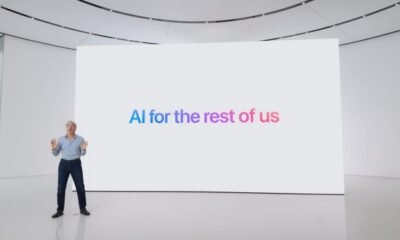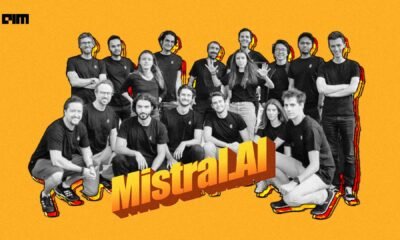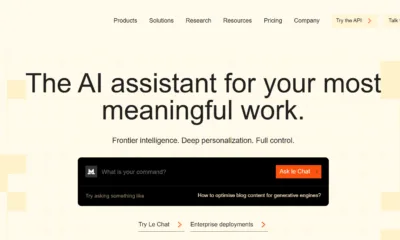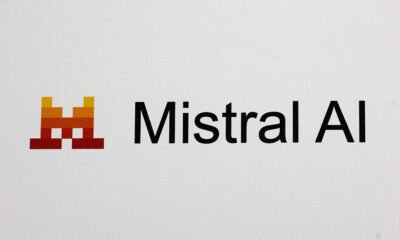Business
What is Mistral AI? Everything to know about the OpenAI competitor
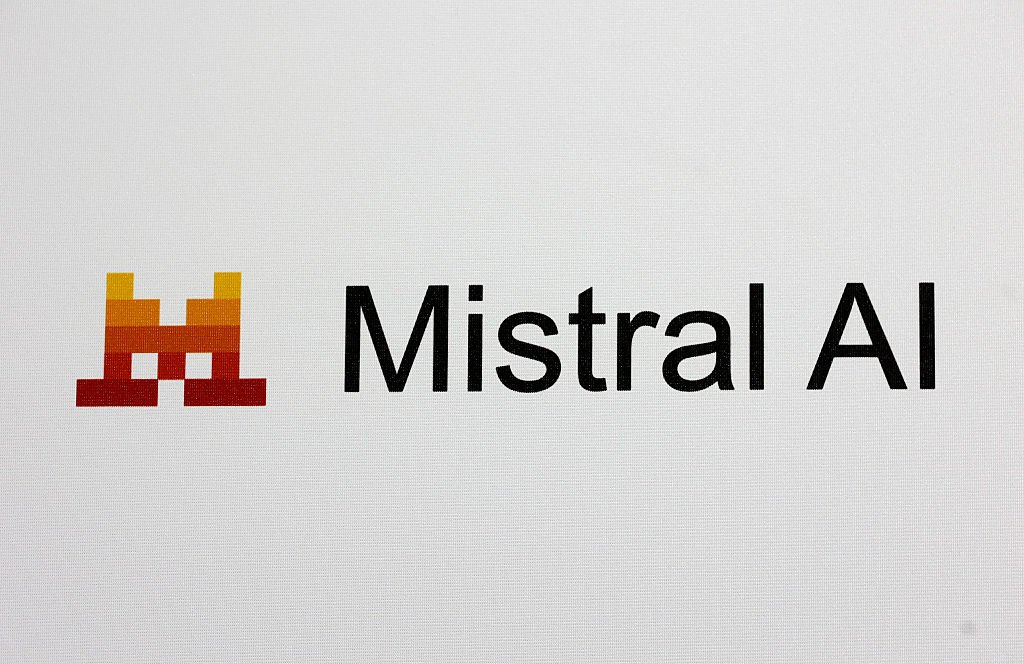
Mistral AI, the French company that develops the AI chatbot Le Chat and several foundational large language models, is considered one of France’s most promising tech startups and is arguably the only European company that could compete with OpenAI.
“Go and download Le Chat, which is made by Mistral, rather than ChatGPT by OpenAI — or something else,” French president Emmanuel Macron said in a TV interview ahead of the AI Action Summit in Paris in February 2025.
In a significant step up from its June 2024 valuation of $6 billion, Mistral is now valued at €11.7 billion (approximately $13.8 billion) following a Series C funding round led by Dutch semiconductor company ASML, which invested €1.3 billion (approximately $1.5 billion) in September, alongside signing a new strategic partnership with the AI company.
ASML’s interest in having its clients benefit from its collaboration is an important milestone for Mistral. While the French company describes itself as “the world’s greenest and leading independent AI lab,” it is still not as well known as its biggest competitors.
What is Mistral AI?
Mistral AI, which offers some open source AI models, has raised significant funding since its creation in 2023, with the ambition to “put frontier AI in the hands of everyone.” While this isn’t a direct jab at OpenAI, the slogan is meant to highlight the company’s openness versus OpenAI’s more recent, closed source take at developing AI models.
Mistral’s chatbot Le Chat is available on iOS and Android, reaching 1 million downloads in the two weeks following its mobile release and grabbing France’s top spot for free downloads on the iOS App Store.
In July 2025, Mistral AI updated Le Chat with new features that bring it closer to rival full-stack AI chatbots: a new “deep research” mode, native multilingual reasoning, and advanced image editing. This update also added Projects, which lets users group chats, documents, and ideas into focused spaces.
Techcrunch event
San Francisco
|
October 27-29, 2025
As of September 2025, Le Chat can remember previous conversations thanks to a feature called Memories.
This is in addition to Mistral AI’s suite of models:
- Mistral Large 2, the primary large language model replacing Mistral Large.
- Pixtral Large, unveiled in 2024 as a new addition to the Pixtral family of multimodal models.
- Magistral, its first family of reasoning models, launched in June 2025.
- Mistral Medium 3, released in May 2025 with the promise of providing efficiency without compromising performance, meant for coding and STEM tasks.
- Voxtral, Mistral’s first open source AI audio model, released in July 2025.
- Devstral, an AI model designed for coding and openly available under the Apache 2.0 license, meaning it can be used commercially without restriction.
- Codestral, an earlier generative AI model for code whose license banned commercial applications.
- “Les Ministraux,” a family of models optimized for edge devices such as phones.
- Mistral Saba, focused on Arabic.
In March 2025, the company introduced Mistral OCR, an optical character-recognition API that can turn any PDF into a text file to make it easier for AI models to ingest.
In June 2025, Mistral AI also released a vibe-coding client, Mistral Code, to compete with Windsurf, Anysphere’s Cursor, and GitHub Copilot.
Who are Mistral AI’s founders?
Mistral AI’s three founders share a background in AI research at major U.S. tech companies that have operations in Paris. Its CEO Arthur Mensch used to work at Google’s DeepMind; CTO Timothée Lacroix and chief scientist officer Guillaume Lample are former Meta staffers.
Mistral’s co-founding advisers include Jean-Charles Samuelian-Werve (also a board member) and Charles Gorintin from health insurance startup Alan. Former digital minister Cédric O is also an adviser to the company, a fact that has caused persistent controversy due to his previous role.
Are Mistral’s models open source?
Not all of them. Mistral differentiates its premier models, whose weights are not available for commercial purposes, from its free models, for which it provides weights under the Apache 2.0 license.
Free models include research models such as Mistral NeMo, built in collaboration with Nvidia which the startup open sourced in July 2024.
How does Mistral make money?
While many of Mistral AI’s offerings are free or now have free tiers, Le Chat also has paid tiers. Introduced in February 2025, Le Chat’s Pro subscription costs $14.99 a month.
On the B2B front, Mistral AI monetizes its premier models through APIs with usage-based pricing. Enterprises can also license these models, and the company likely also generates a significant share of its revenue from its strategic partnerships, some of which it highlighted during the Paris AI Summit.
Overall, however, Mistral AI’s revenue is reportedly in the eight-digit range, according to multiple sources.
What partnerships has Mistral AI closed?
In 2024, Mistral AI signed a deal with Microsoft that included a €15 million investment and a strategic partnership for distributing the French company’s AI models through Microsoft’s Azure platform.
The U.K.’s Competition and Markets Authority (CMA) swiftly concluded that the deal didn’t qualify for investigation due to its small size, though the deal sparked some criticism in the EU.
In January 2025, Mistral signed a deal with press agency Agence France-Presse (AFP) to let Le Chat query the AFP’s entire text archive dating back to 1983.
Mistral AI also secured strategic partnerships with France’s army and job agency, Luxembourg, shipping giant CMA, German defense tech startup Helsing, IBM, Orange, and Stellantis.
In May 2025, Mistral said it would participate in the creation of an AI Campus in the Paris region, as part of a joint venture with UAE-investment firm MGX, NVIDIA, and France’s state-owned investment bank Bpifrance.
In June 2025, Mistral said it would launch a European platform dedicated to AI and powered by Nvidia processors, Mistral Compute, in 2026. The initiative was hailed as “historic” by Macron, who shared the stage with Mensch and Nvidia CEO Jensen Huang at the VivaTech conference shortly after the announcement.
In July 2025, Mistral launched AI for Citizens, an initiative that the company claimed could “help States and public institutions strategically harness AI for their people by transforming public services.”
In September 2025, Mistral and chip company ASML struck a partnership “to explore the use of AI models across ASML’s product portfolio as well as research, development and operations.”
What enterprise features has Mistral AI developed?
In May 2025, Mistral AI released the Mistral Agents API to “empower enterprises to use AI in more practical and impactful ways,” according to its Head of Developer Relations, Sophia Yang.
In September 2025, the company unveiled a revamped Connectors directory, showcasing Le Chat’s integrations with some 20 enterprise tools, including Asana, Atlassian, Box, Google Drive, Notion, and Zapier, as well as emails and calendars; and soon, Databricks and Snowflake.
How much funding has Mistral AI raised to date?
By February 2025, Mistral AI had raised a total of around €1 billion, some of which was debt financing. The money was raised across several equity rounds conducted in close succession.
In June 2023, just one month after being founded, Mistral AI raised a record $113 million seed round led by Lightspeed Venture Partners. Sources at the time said the seed round, Europe’s largest ever, valued the startup at $260 million.
Other investors in that round included Bpifrance, Eric Schmidt, Exor Ventures, First Minute Capital, Headline, JCDecaux Holding, La Famiglia, LocalGlobe, Motier Ventures, Rodolphe Saadé, Sofina, and Xavier Niel.
Six months later, Mistral closed a €385 million Series A ($415 million at the time), at a reported valuation of $2 billion. The round was led by Andreessen Horowitz and saw participation from Lightspeed, as well as BNP Paribas, CMA-CGM, Conviction, Elad Gil, General Catalyst, and Salesforce.
Microsoft’s $16.3 million convertible investment in Mistral as part of a partnership announced in February 2024 was presented as a Series A extension, implying an unchanged valuation.
In June 2024, Mistral raised €600 million (about $640 million) in a mix of equity and debt. The long-rumored round was led by General Catalyst at a $6 billion valuation, with notable investors including Cisco, IBM, Nvidia, and Samsung Venture Investment Corporation participating.
Earlier this year, Mistral AI was rumored to be finalizing a €2 billion investment at a post-money valuation of $14 billion. This followed earlier reports that the company was in talks to raise $1 billion in equity from investors, who included Abu Dhabi’s MGX fund, as well as hundreds of millions of euros in debt.
On September 9, 2025, Mistral closed a €1.7 billion (about $2 billion) Series C round led by ASML at a €11.7 billion (approximately $13.8 billion) valuation. According to the company, the round saw investments from existing backers DST Global, Andreessen Horowitz, Bpifrance, General Catalyst, Index Ventures, Lightspeed, and NVIDIA.
How is Mistral AI approaching AI regulation?
Mensch was part of a group of European CEOs who signed an open letter in July 2025 urging Brussels to “stop the clock” for two years before key obligations of the EU Artificial Intelligence Act enter into force. The European Commission is sticking to its original timeline.
What could a Mistral AI exit look like?
Mistral is “not for sale,” Mensch said in January 2025 at the World Economic Forum in Davos. “Of course, [an IPO is] the plan.”
This makes sense, given how much the startup has raised so far: Even a large sale may not provide high enough multiples for its investors, not to mention sovereignty concerns depending on the acquirer.
However, the only way to definitely squash persistent acquisition rumors — lately naming Apple — is to scale its revenue to levels that could even remotely justify its valuation. Either way, stay tuned.
This story was originally published on February 28, 2025, and will be regularly updated.
Business
The super-rich are swapping mansions for £2m motorhomes. Do they know something we don’t? | Emma Beddington

I don’t particularly enjoy analysing the habits of the ultra-rich. I would be happier if I didn’t have to think about them at all – and I apologise for making you do so – but in my defence, this is fascinating: a feature in the Financial Times reveals some have started selling up and living in motorhomes.
Obviously, they’re ultra-luxurious motorhomes. The owner of a private equity firm interviewed has a 30-tonne behemoth with air conditioning and high-speed internet, a kitchen, dining room, two bathrooms, a “spacious master bedroom” and “a range of modern hi-tech appliances”. Which, yes, sounds plusher than my in-laws’ caravan, but it’s still a massive shed on wheels. And you’ll never guess how much they cost: “around $2.7m” (£2m), apparently. Imagine the bricks-and-mortar house you could get for that – that private equity chap sold both of his – and you wouldn’t have to empty a toilet tank. (Maybe they outsource that somehow, but still.)
Weirder still, for long periods these wheeled vehicles and their occupants don’t move, despite that being, you’d think, the whole point. Instead, they park up – and imagine parking something 13 metres long, the horror – in places called things like Motorcoach Country Club but which sound like gussied-up trailer parks. Owners buy permanent plots with, the FT explains, “pools, covered patios, barbecue areas, fire pits, and small homes with living rooms and bedrooms”. So, hang on – you buy a giant, more-than-million-pound motorhome, then you don’t live in it, instead hanging out in a sort of small chalet structure with a view of your massive truck? I nearly lost my mind after I spent three days in Center Parcs; these plutocrats are spending months in the equivalent voluntarily, when they could be jetting off to some White Lotus-style resort to have their every whim indulged, or being heli-dropped at the top of a mountain to protect their peace.
It’s like a perverse reversal of Nomadland, the book and subsequent film that explored the lives of struggling Americans living peripatetically in vans from necessity after the 2008 recession. Are rich people so tired of luxury they’re doing this just to feel something? Is it a Common People socioeconomic tourism thing: if you called your real-estate broker, he could stop it all?
Initially I was, at most, mildly entertained by this – it’s just a microtrend, albeit a baffling one that seems to confirm my conviction that wealth is wasted on the wealthy. But then I read something else about ultra-high-net-worthers: they’ve started renting rather than buying property, with the number doing so tripling between 2019 and 2023 in the US, according to the New York Times. Something similar is happening in the UK, with high-end properties being rented and tenants potentially buying later once they’ve tested the water. The founder of the private car hire company Addison Lee, Sir John Griffin, has apparently put his place on the rental market for £75,000 a month.
At those kinds of prices, I’m sure none of them are dealing with black mould or unfairly retained deposits, but it’s still unexpected. I can’t imagine preferring transience and uncertainty over permanence. So why? As a real-estate broker told the New York Times, they’re “choosing flexibility and liquidity over ownership. They don’t want to be bothered with the inconveniences of home ownership, which includes paying real-estate taxes and insurance, especially in markets like Florida and California, where we’re seeing a lot of natural catastrophes.” “Flexibility is the name of the game in today’s market,” the Times confirms.
And, huh – perhaps that’s the explanation? In a world that feels dangerous and unpredictable, increasingly prey to “natural catastrophes” (and unnatural ones), the ultra-rich are learning from their hedge-funder friends and they’re hedging. They’re prepping for any eventuality, but with a luxe 30-tonne RV rather than a government-recommended grab bag. Maybe that’s the most important thing money can buy these days: the ability to get the hell out of Dodge at a moment’s notice.
Business
Apprenticeships have collapsed in England – Labour needs to fine-tune the solution, fast | Heather Stewart

Ensuring England’s workforce has the right skills for a rapidly changing economy is key to Labour’s hopes of boosting social mobility and kickstarting economic growth.
So it seems unfortunate that more than a week after Keir Starmer’s drastic reshuffle, ministers are still wrangling about exactly which bits of the skills agenda will now move to Pat McFadden’s beefed up Department for Work and Pensions (DWP).
Broadly speaking, the education secretary, Bridget Phillipson, is expecting to hang on to responsibility for further education, while McFadden will probably take on apprenticeships and adult skills. Lady Jacqui Smith, the skills minister, will work across both departments.
Labour market experts say there is some logic to the shift: ensuring the right training is available in the right places is one crucial part of tackling the issue of economic inactivity in a rapidly changing employment market, which falls within the DWP’s bailiwick.
But “machinery of government” changes, as official parlance has it, can often bring more disruption than clarity.
Over the past two decades alone, responsibility for skills has bounced around Whitehall, from education into the short-lived Department of Innovation, Universities and Skills (2007-2009) then on to the Department for Business, Innovation and Skills (2009-2016), back into education again, and now across to DWP.
Perhaps this nomadic status helps account for successive administrations’ chronic neglect. Government spending on adult education halved between 2011 and 12 and 2019 and 2020. It then recovered somewhat as the worst years of austerity came to an end, but by last year it was still £1bn down in real terms.
Meanwhile, despite endless speeches by politicians of all stripes about how vocational skills should have the same status as university (I have sat through quite a few: it is compulsory to mention Germany), the numbers completing apprenticeships have collapsed.
Official figures show that 178,220 people earned an apprenticeship in England in 2023-24 – down by more than a third on 2017-18, when the Apprenticeship Levy was introduced.
Recently rebranded as the Skills and Growth levy, this is charged at 0.5% of the payroll of larger firms. It was meant to encourage a flowering of workplace training, although employers have long complained that it is too rigid.
Since Labour came to power, Phillipson has made some changes, cutting the minimum duration of an apprenticeship to eight months.
Enrolment in apprenticeships has risen this year, by just over 2% but business groups are still hoping for a more substantial shake-up.
Companies have their own significant part to play, too. It must surely be a piece of the UK’s productivity “puzzle,” that according to the Learning and Work Institute, employers’ annual spending on training for each member of staff has fallen by 28% in real terms since 2005, to £1,530, a level less than half the EU average.
Longtime education expert Sir Philip Augur put it well in a recent Institute for Fiscal Studies podcast about post-16 education.
Welcoming the changes to the apprenticeship levy, Augur said: “Employers have to step up to the plate here. For employers, ‘I can’t get the staff,’ is quite often an excuse for bad management. Now on this occasion, they can’t get the staff because the skills aren’t there. But there needs to be honesty and self-appraisal on the part of employers.”
Augure called for the levy to rise “very slightly”, to free up more resources for expanding apprenticeships.
after newsletter promotion
McFadden is, say his team, keen to ensure that young people get the skills they need to benefit from the jobs scheduled to be created by new government investment in defence and green energy. That will mean working with firms and unions to get the training landscape right.
There is plenty of innovative thinking going on at local level. The West Yorkshire mayor, Tracy Brabin, announced plans last week for what she called “skills-led growth”, in Wakefield, the UK’s largest city without a university.
She hopes to establish a new Wakefield Futures Centre, led by employers, where local people can do courses directly linked to finding work in the fastest-growing sectors in the surrounding economy.
The idea is to make the courses flexible so that adults with caring responsibilities, for example, can take up the offer.
This kind of relatively fluid, employer-connected approach might allow mums to pick up new skills, or older workers to switch sector or dip their toe in the market after a period off sick, for example.
It might also be used to tempt young people to think about a wider set of options: in Manchester, Andy Burnham is pushing to set up an MBacc – an EBacc equivalent, a qualification intended to be an alternative to GCSEs, which is tailored to local jobs.
Jobcentres, which are getting a rejig under Labour to present a more encouraging face, can then signpost to local opportunities such as these.
Getting the skills offer right will have to form one crucial part of any genuine effort to bring down the UK’s unusually high economic inactivity rates, and therefore, ultimately, the welfare bill.
Last year’s crass attempt at cuts failed because Labour could not justify to its own MPs the crude way in which it planned to cut eligibility for the personal independence payment (Pip).
If the government wants to have another go – as McFadden certainly does – then a fresh skills and training offer could be part of the package for the hard-to-reach claimants Labour said it had a “moral case” to help last time – but for whom across-the-board Pip cuts would have done nothing.
It’s not a quick fiscal fix by any means, but get it right and the upside, for individuals, employers and the economy, would be significant and long-lasting. The sooner ministers can clear up who takes on which bits of the task, and crack on with it, the better.
Business
How Ancestry Decides Which AI to Use to Synthesize Its Data Trove

There’s a fierce battle underway in Silicon Valley, and there’s one piece of technology at the center of it all: AI.
When OpenAI released its AI-powered chatbot, ChatGPT, in 2022, it introduced large language models to the broader public and was embraced by business leaders. It also cast a glaring spotlight on its competitors, some of whom raced to release their own AI-powered chatbots.
The growing number of LLMs poses a tricky question for companies determining which model to use.
Sriram Thiagarajan, Ancestry’s chief technology officer and executive vice president of product and technology, told Business Insider that the company is taking a more-the-merrier approach.
“We are agnostic to LLM models,” Thiagarajan said. “We use multiple AI models. Be it Azure, OpenAI, Meta’s Lama, or offerings under Amazon Bedrock.”
For Ancestry, a Utah-based genealogy company that sells DNA test kits, the AI model’s brand is less important than the end result.
“We built an abstraction layer — what we call an AI gateway — on top that helps us leverage whatever models better fit our case,” he said. “We have built our own agentic framework in a way that helps us provide that unique family story and personalized experience for our consumers.”
Ancestry and AI
Thiagarajan said Ancestry had just begun diving into AI and machine learning when he joined the company in 2017.
At that time, Ancestry was trying to find an efficient way to digitize content, which is a massive undertaking for the company. Ancestry collects numerous forms of records, including birth, death, military, land, immigration, census, and newspapers.
“We’ve collected over 65 billion records across 80-plus countries,” Thiagarajan said. “Just to give a scale, that’s about 10,000 terabytes of data on our platform that we use to provide discoveries to our users.”
In the past, processing and identifying troves of records took months.
“About 15 or 20 years ago, when we digitized the 1940 census, it took us about nine months to do it in a manual way at 10 times the cost,” Thiagarajan said.
Then, the company embraced AI.
“We said, ‘Why don’t we apply computer vision AI techniques to automatically digitize content without manual intervention?’ Thiagarajan said. “Fast forward to the 2021 timeframe, we used our own proprietary handwriting recognition computer vision technologies, and we compressed the time to market to under nine days from nine months at a fraction of the cost.”
Still, Sriram said the company relies on humans to fact-check the AI answers “as needed.”
“We’ve built some automated controls and systems that certainly reduce the amount of time we need to spend checking,” he said. “We want to be extra careful in making sure that what we produce using AI is grounded in truth. Grounded in facts.”
These days, Ancestry is going all in on the tech — especially with its employees.
“There are a lot of things we do to drive AI education within the company,” he said. “Be it brown bag lunches, internal forums, or providing an environment where people across departments can experiment.”
Hackathons are also regular events at Ancestry and provide a space for collaboration across teams.
“So encouraging innovation as part of the flow of work, as they call it, as opposed to that residing as a silo,” Thiagarajan said.
-

 Business2 weeks ago
Business2 weeks agoThe Guardian view on Trump and the Fed: independence is no substitute for accountability | Editorial
-
Tools & Platforms1 month ago
Building Trust in Military AI Starts with Opening the Black Box – War on the Rocks
-

 Ethics & Policy2 months ago
Ethics & Policy2 months agoSDAIA Supports Saudi Arabia’s Leadership in Shaping Global AI Ethics, Policy, and Research – وكالة الأنباء السعودية
-

 Events & Conferences4 months ago
Events & Conferences4 months agoJourney to 1000 models: Scaling Instagram’s recommendation system
-

 Jobs & Careers3 months ago
Jobs & Careers3 months agoMumbai-based Perplexity Alternative Has 60k+ Users Without Funding
-

 Podcasts & Talks2 months ago
Podcasts & Talks2 months agoHappy 4th of July! 🎆 Made with Veo 3 in Gemini
-

 Education2 months ago
Education2 months agoVEX Robotics launches AI-powered classroom robotics system
-

 Education2 months ago
Education2 months agoMacron says UK and France have duty to tackle illegal migration ‘with humanity, solidarity and firmness’ – UK politics live | Politics
-

 Funding & Business3 months ago
Funding & Business3 months agoKayak and Expedia race to build AI travel agents that turn social posts into itineraries
-

 Podcasts & Talks2 months ago
Podcasts & Talks2 months agoOpenAI 🤝 @teamganassi




